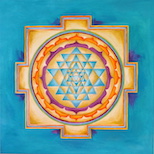In one of the seated postures:
– simple sitting position with legs crossed (sukhasana),
– a semi-lotus position (ardha padmasana), the foot touches the inside of the opposite thigh, the other foot rests on the thigh,
– full lotus (padmasana) – the upper sides of both feet rest on the thighs,
– accomplished or perfect yogic posture for men (siddhasana) – right foot to the inside of the thigh where the heel presses the perineum (part of the body between the genitals and anus), toes and the outside of the left foot between the thigh and the calf of the right leg,
– complete or perfect posture for women (siddha yoni asana) – the reverse of siddhasana, yoni means the womb. Siddha is a perfect, accomplished, powerful soul, which of course does not mean that everyone who sits in the siddhasana is a perfect, accomplished, powerful soul who has realized her being, meaning carefully with self-diagnosis and diagnosis.
– or in the position of pure happiness of existence (swastikasana) – as siddhasana, without touching the perineum. Swastika is a symbol of the unification of all sides of the universe at its center.
While sitting in one of these positions, the inner sound of OM in the right ear is heard.
This sound is called anahathanada, the sound of the heart. When a man focuses on the Nada sound it suppresses external sounds and thus brings both “wings” of the pranava mantra under control. This brings him to the fourth state of consciousness.
Chanting is at first louder and over time the sound will be brought to the most subtle vibrations.
At first, the yogi can hear the sound of the sea, clouds, weaker sound of drum or the sound of the fountain.
During careful listening to the inner sounds of yoga one needs to look for the subtle ones. So a man will focus his concentration and isolate himself from external sounds.
As in everything energy flows where it is directed. If a man can fully concentrate on the inner sound, both himself and the Nada melt with that sound.
When a man merge himself with Nada he can unity himself with the inner space of consciousness (chidakasha). In this state of complete self-control and the most honest practice, he slowly enters the state of non-mind. This state occurs when a person completely and effortlessly separates himself from thought.
The idea of space is present as much as the words (sounds) are present.
The mind is present as long there is a sound.




 The right wing of the swan carries the mantra A, the left wing mantra U and the tail the mantra M.
The right wing of the swan carries the mantra A, the left wing mantra U and the tail the mantra M.